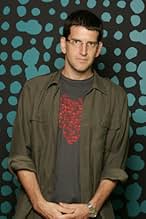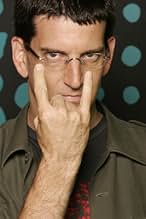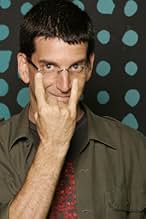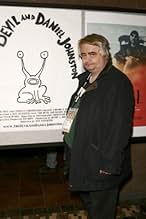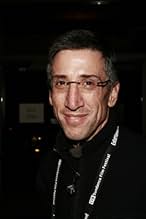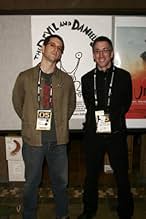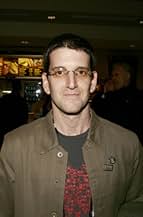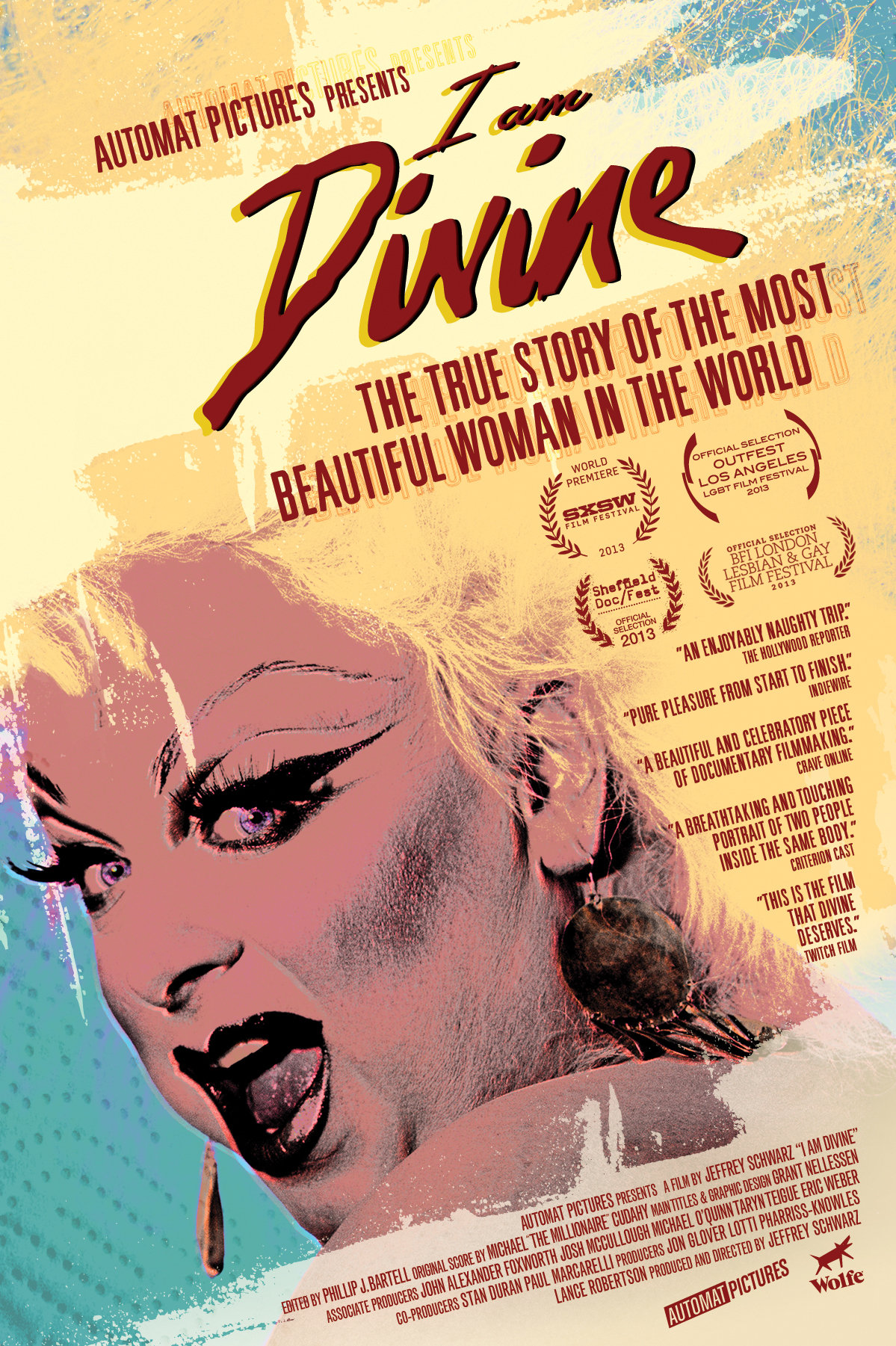IMDb रेटिंग
7.9/10
11 हज़ार
आपकी रेटिंग
अपनी भाषा में प्लॉट जोड़ेंDaniel Johnston, manic-depressive genius singer/songwriter/artist is revealed in this portrait of madness, creativity and love.Daniel Johnston, manic-depressive genius singer/songwriter/artist is revealed in this portrait of madness, creativity and love.Daniel Johnston, manic-depressive genius singer/songwriter/artist is revealed in this portrait of madness, creativity and love.
- पुरस्कार
- 2 जीत और कुल 3 नामांकन
Freddie Mercury
- Self
- (आर्काइव फ़ूटेज)
फ़ीचर्ड समीक्षाएं
The first section of the film has to do with the early life of Daniel Johnston as well as his being discovered by the musical world in the 1980s. Most of this didn't interest me at all--especially because I hated his music. When the film tried to convince me of his genius, it completely lost me, as he sounded just awful and hurt my ears (though I do acknowledge that he does have a small cult following who see him as a great genius). He definitely is not nor ever has been "mainstream" and this section of the film was poor compared to the last 3/4 of the film. It just didn't do much to compel the average viewer.
However, when it talked about his descent into madness, then the film came to life and became much more compelling. This section of the film was much longer and seemed to be the most important point of this documentary. The impact on Daniel, his family and those around him was profound and very sad to watch.
Because of my background, I have additional insight into the psychiatric state of Daniel Johnston during the film. As I watched, I noticed that although the film mentions that Daniel had "Manic-Depressive Disorder" (i.e., Bipolar Disorder), there was compelling evidence that a more correct diagnosis might have been a Schizoaffective Disorder. In essence, this is Bipolar Disorder along with Schizophrenia, as Daniel's behaviors and thinking always have a bizarreness that isn't classic "mania"--where you'd typically see bizarreness mostly during manic stages. He was so disorganized, occasionally hostile and had such bizarre thinking that this seems like the correct diagnosis instead of Bipolar Disorder. His talking about demons and obsession with his own self-styled religion is just plain weird. Additionally, the hospital prescribing Haldol is indicative of a more severe thought disorder. Normally, with a Bipolar Disorder, they would prescribe antidepressants or Lithium--not a severe mind-altering drug like Haldol. Haldol is practically an elephant tranquilizer and patients on it often are somewhat zombie-like--and it's often given to violent and severely psychotic patients in emergency rooms.
Late in the film, there was an emphasis on Daniel's artwork--not just his music. Despite many declaring it to be great, I found it fascinating because it gave great insight into Daniel's twisted vision of the world--with drawings of devils, monsters and a man whose head is cut in half (a representation of himself). Did I think it was "great"? No--far from it, but the insight it gave was incredible. And, at times, the claims others made about his greatness seemed a bit like hyperbole (saying he was the equal to Brian Wilson for example).
A fascinating film that was well-constructed--using audio tapes, video, interviews and a few scenes of Daniel today. Well made and worth a look.
However, when it talked about his descent into madness, then the film came to life and became much more compelling. This section of the film was much longer and seemed to be the most important point of this documentary. The impact on Daniel, his family and those around him was profound and very sad to watch.
Because of my background, I have additional insight into the psychiatric state of Daniel Johnston during the film. As I watched, I noticed that although the film mentions that Daniel had "Manic-Depressive Disorder" (i.e., Bipolar Disorder), there was compelling evidence that a more correct diagnosis might have been a Schizoaffective Disorder. In essence, this is Bipolar Disorder along with Schizophrenia, as Daniel's behaviors and thinking always have a bizarreness that isn't classic "mania"--where you'd typically see bizarreness mostly during manic stages. He was so disorganized, occasionally hostile and had such bizarre thinking that this seems like the correct diagnosis instead of Bipolar Disorder. His talking about demons and obsession with his own self-styled religion is just plain weird. Additionally, the hospital prescribing Haldol is indicative of a more severe thought disorder. Normally, with a Bipolar Disorder, they would prescribe antidepressants or Lithium--not a severe mind-altering drug like Haldol. Haldol is practically an elephant tranquilizer and patients on it often are somewhat zombie-like--and it's often given to violent and severely psychotic patients in emergency rooms.
Late in the film, there was an emphasis on Daniel's artwork--not just his music. Despite many declaring it to be great, I found it fascinating because it gave great insight into Daniel's twisted vision of the world--with drawings of devils, monsters and a man whose head is cut in half (a representation of himself). Did I think it was "great"? No--far from it, but the insight it gave was incredible. And, at times, the claims others made about his greatness seemed a bit like hyperbole (saying he was the equal to Brian Wilson for example).
A fascinating film that was well-constructed--using audio tapes, video, interviews and a few scenes of Daniel today. Well made and worth a look.
I had the opportunity to see this film several days ago while working at the American Film Market, and I have been telling everyone I know to see it. I'm not sure what the deal is with a wide release, but everyone who loves documentary should see this one when it comes out.
For those of you who aren't familiar with the title character, Daniel Johnston is a manic- depressive artist/musician who currently resides in Waller, Texas with his elderly parents. I had been a fan of his music for sometime, and also having lived in Austin, had been aware of his status as a local fixture, but there was so much fascinating information divulged in this film that I never knew about. The film spans the life (up to the present) of this incredibly complex person, who truly resides in a world of his own creation. It's clear that the filmmaker has a deep appreciation and love for Johnston's work, and his world is painstakingly brought to life through animation, recreation, and wonderfully edited home movies and audio cassette tapes. His friends and family also offer insight into the various events which were pivotal in Johnston's life.
The wealth of self-documentation that Johnston has created over his life, starting from childhood, is one of the things that makes this film truly magnificent. Over the years, we can literally see this person change before our eyes, as though gradually being claimed by a dark force. The "dark force" in this case is manic depression; metaphorically The Devil for Johnston, who is a devout Christian. Johnston's struggle to connect with people he loves through the fog of his illness is devastating. While this can be difficult to watch (at least for me), there is the powerful reward of the music and drawings that Johnston has produced throughout, both in spite of and as a direct result of this struggle. That something heartbreakingly beautiful in it's simplicity and honestly can come from such a terrible struggle, is what makes this story and this film remarkable.
For those of you who aren't familiar with the title character, Daniel Johnston is a manic- depressive artist/musician who currently resides in Waller, Texas with his elderly parents. I had been a fan of his music for sometime, and also having lived in Austin, had been aware of his status as a local fixture, but there was so much fascinating information divulged in this film that I never knew about. The film spans the life (up to the present) of this incredibly complex person, who truly resides in a world of his own creation. It's clear that the filmmaker has a deep appreciation and love for Johnston's work, and his world is painstakingly brought to life through animation, recreation, and wonderfully edited home movies and audio cassette tapes. His friends and family also offer insight into the various events which were pivotal in Johnston's life.
The wealth of self-documentation that Johnston has created over his life, starting from childhood, is one of the things that makes this film truly magnificent. Over the years, we can literally see this person change before our eyes, as though gradually being claimed by a dark force. The "dark force" in this case is manic depression; metaphorically The Devil for Johnston, who is a devout Christian. Johnston's struggle to connect with people he loves through the fog of his illness is devastating. While this can be difficult to watch (at least for me), there is the powerful reward of the music and drawings that Johnston has produced throughout, both in spite of and as a direct result of this struggle. That something heartbreakingly beautiful in it's simplicity and honestly can come from such a terrible struggle, is what makes this story and this film remarkable.
10lokidog
This film take you on a journey into a creative genius' struggle with life. Daniel Johnston recorded his entire life on cassette tape and his early life on film. Later he appeared on MTV, and in venues in Austin, TX on film and video. These provide the film-maker with a wide array of media for telling this story.
Jeff Feuerzeig weaves this material seamlessly into what is one of the most emotionally wrenching films I've seen in the last year and one of my favorite documentaries ever. It is hard to compare this film with documentaries like those of Michael Moore which are comedic and topical, or those of Errol Morris, which tend to focus on issues and facts. This documentary brings emotional threads and creativity into play in a way that dissolves the usual harsh contrast between a story and it's telling. You forget you are watching a documentary film, and become immersed in Daniel's life. Daniel's effect on those around him is interwoven with his own recordings. His family and friend are there to add to his story to show how his life is reflected upon them. Feuerzeig use of Daniel's parents narrative is simply masterful - it provides important information, and at the same time illustrates the the emotional turmoil his illness causes in the lives of those that love him. Daniel's family is portrayed from the early period of his illness when they have no idea what mental illness really means, to the present time when they become his supporters and advocates. Eventually, family and friend's are shown coming to terms with Daniel's mental illness, and experience their own emotional growth as well.
It deservedly won the Directors Award at Sundance 2005, and I think it would have won the audience award if it had a different play schedule.
Jeff Feuerzeig weaves this material seamlessly into what is one of the most emotionally wrenching films I've seen in the last year and one of my favorite documentaries ever. It is hard to compare this film with documentaries like those of Michael Moore which are comedic and topical, or those of Errol Morris, which tend to focus on issues and facts. This documentary brings emotional threads and creativity into play in a way that dissolves the usual harsh contrast between a story and it's telling. You forget you are watching a documentary film, and become immersed in Daniel's life. Daniel's effect on those around him is interwoven with his own recordings. His family and friend are there to add to his story to show how his life is reflected upon them. Feuerzeig use of Daniel's parents narrative is simply masterful - it provides important information, and at the same time illustrates the the emotional turmoil his illness causes in the lives of those that love him. Daniel's family is portrayed from the early period of his illness when they have no idea what mental illness really means, to the present time when they become his supporters and advocates. Eventually, family and friend's are shown coming to terms with Daniel's mental illness, and experience their own emotional growth as well.
It deservedly won the Directors Award at Sundance 2005, and I think it would have won the audience award if it had a different play schedule.
Many of the great artists of history have suffered from some form of mental disorder, and we often find ourselves fascinated both by their brilliance and their madness. Of course, as this documentary points out, none of us ever had to actually live with a Van Gogh or a Lord Byron and deal with the real world consequences of what went on in their heads.
In The Devil and Daniel Johnston, Jeff Feuerzeig gives us a rare glimpse into the tortured mind of just such brilliant artist by effectively combining interviews from those who have known Daniel Johnston best with Johnston's own internal monologue. Feuerzeig achieves the latter because, apart from recording hundreds of songs on cassette tapes, Daniel recorded much of his life; from his mother screaming at him as a teenager to his arrest by park officials for painting Jesus fish on the Statue of Liberty to Johnston reading aloud about his own mental illness from the Diagnostic and Statistical Manual of Mental Disorders.
Many people came to know Daniel Johnston's work in the early 90s when Kurt Cobain famously called him the "greatest songwriter on Earth" and wore a t-shirt with an image from one of Johnston's hand-drawn album covers on the MTV Video Music Awards. Johnston's raw and introspective songs were subsequently covered by Nirvana, Sonic Youth, The Flaming Lips, Beck, and many others. Sadly, just as his music was making inroads into the popular consciousness Johnston's mental illness worsened (possibly accelerated by heavy LSD use), and his career and life entered increasingly troubled waters.
The Devil and Daniel Johnston works as a documentary about music, art, and mental illness all at the same time. It grants you unusual access to what's going on inside a the mind of a human being bursting with creative talent while simultaneously struggling to control the demons that haunt him. After watching this, don't be surprised if you find yourself wanting to hear more of Daniel Johnston's work.
In The Devil and Daniel Johnston, Jeff Feuerzeig gives us a rare glimpse into the tortured mind of just such brilliant artist by effectively combining interviews from those who have known Daniel Johnston best with Johnston's own internal monologue. Feuerzeig achieves the latter because, apart from recording hundreds of songs on cassette tapes, Daniel recorded much of his life; from his mother screaming at him as a teenager to his arrest by park officials for painting Jesus fish on the Statue of Liberty to Johnston reading aloud about his own mental illness from the Diagnostic and Statistical Manual of Mental Disorders.
Many people came to know Daniel Johnston's work in the early 90s when Kurt Cobain famously called him the "greatest songwriter on Earth" and wore a t-shirt with an image from one of Johnston's hand-drawn album covers on the MTV Video Music Awards. Johnston's raw and introspective songs were subsequently covered by Nirvana, Sonic Youth, The Flaming Lips, Beck, and many others. Sadly, just as his music was making inroads into the popular consciousness Johnston's mental illness worsened (possibly accelerated by heavy LSD use), and his career and life entered increasingly troubled waters.
The Devil and Daniel Johnston works as a documentary about music, art, and mental illness all at the same time. It grants you unusual access to what's going on inside a the mind of a human being bursting with creative talent while simultaneously struggling to control the demons that haunt him. After watching this, don't be surprised if you find yourself wanting to hear more of Daniel Johnston's work.
I saw this little gem at the Berlinale film festival in Berlin, with the director and the producer present. It is about the life and work of Daniel Johnston, a US singer/songwriter/painter with a manic depressive condition. In opposite to the director and many of the people participating in the movie, I do not regard Daniel Johnston as a genius, but he still is a very interesting character, and some of his songs and paintings are very moving. The film is very well done, quite uplifting and entertaining, with a big love for the main character and at the same time a nice and unoffensive sense of humor. I definitely recommend it, whether you are a fan of Daniel Johnstion or not. 9 out of 10.
क्या आपको पता है
- ट्रिवियाAs seen in the DVD extras, Daniel and Laurie would meet again after 30+ years following a screening of this film. She said she kept every memento he gave her and was grateful that he always built up her self esteem and said so many nice things to her when they were friends. The two shared a beautiful moment with a nice hug when they saw each other again.
- भाव
Daniel Johnston: I never met a girl I didn't meet.
- कनेक्शनFeatured in Segundo aniversario (2007)
- साउंडट्रैकSilly Love
Written by Daniel Johnston
Performed by Daniel Johnston
Published by Eternal Yip Eye Music (BMI)
Administered by BUG Music Publishing
टॉप पसंद
रेटिंग देने के लिए साइन-इन करें और वैयक्तिकृत सुझावों के लिए वॉचलिस्ट करें
- How long is The Devil and Daniel Johnston?Alexa द्वारा संचालित
विवरण
बॉक्स ऑफ़िस
- US और कनाडा में सकल
- $3,34,450
- US और कनाडा में पहले सप्ताह में कुल कमाई
- $23,192
- 2 अप्रैल 2006
- दुनिया भर में सकल
- $4,32,339
- चलने की अवधि1 घंटा 50 मिनट
- रंग
- ध्वनि मिश्रण
- पक्ष अनुपात
- 1.85 : 1
इस पेज में योगदान दें
किसी बदलाव का सुझाव दें या अनुपलब्ध कॉन्टेंट जोड़ें



